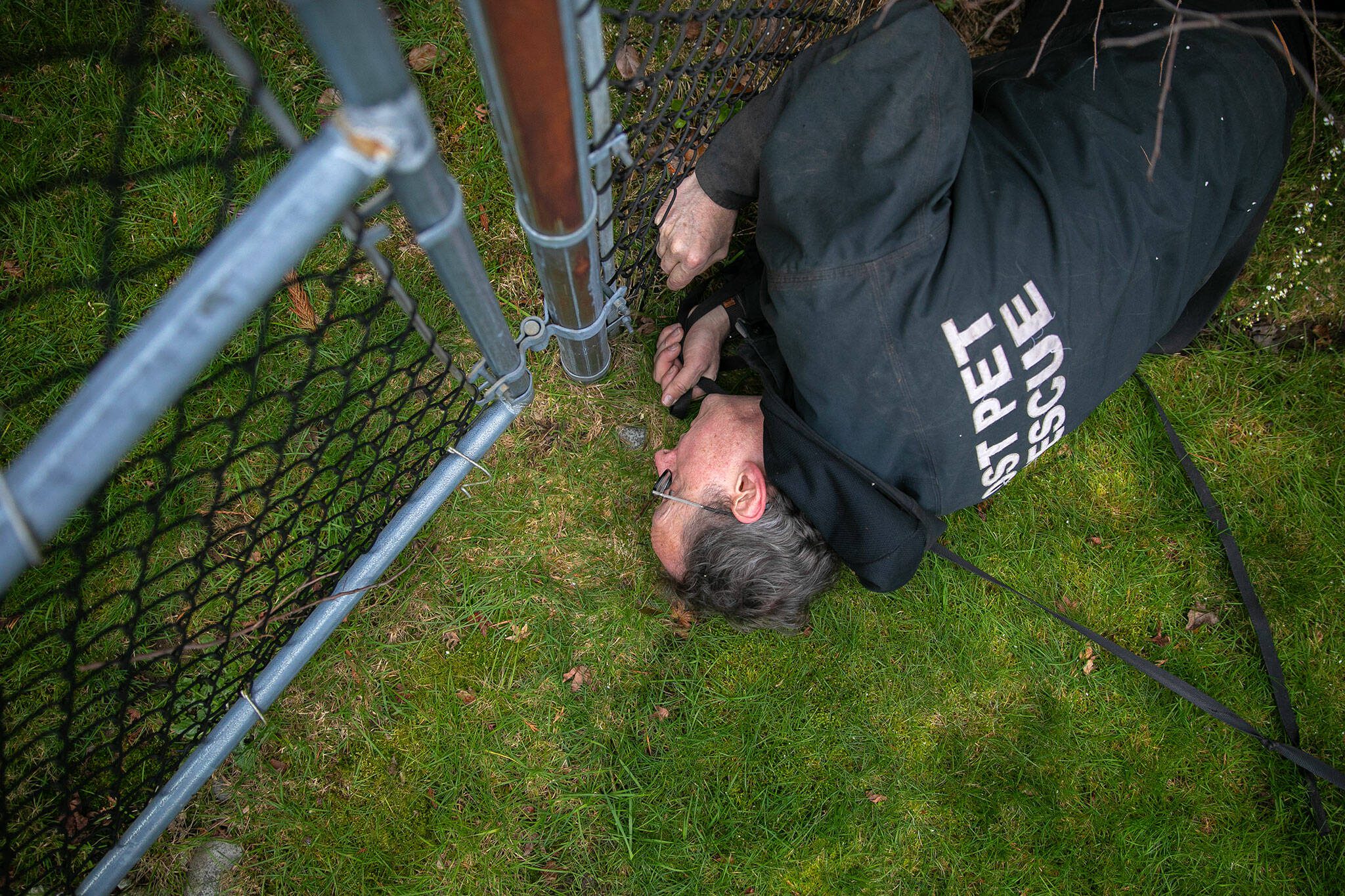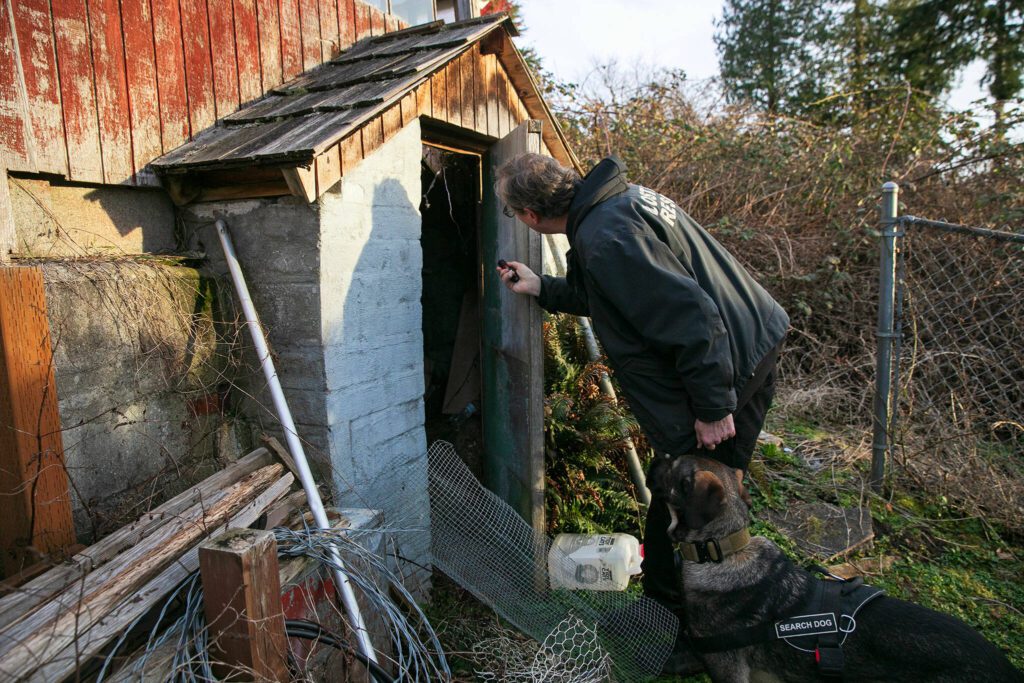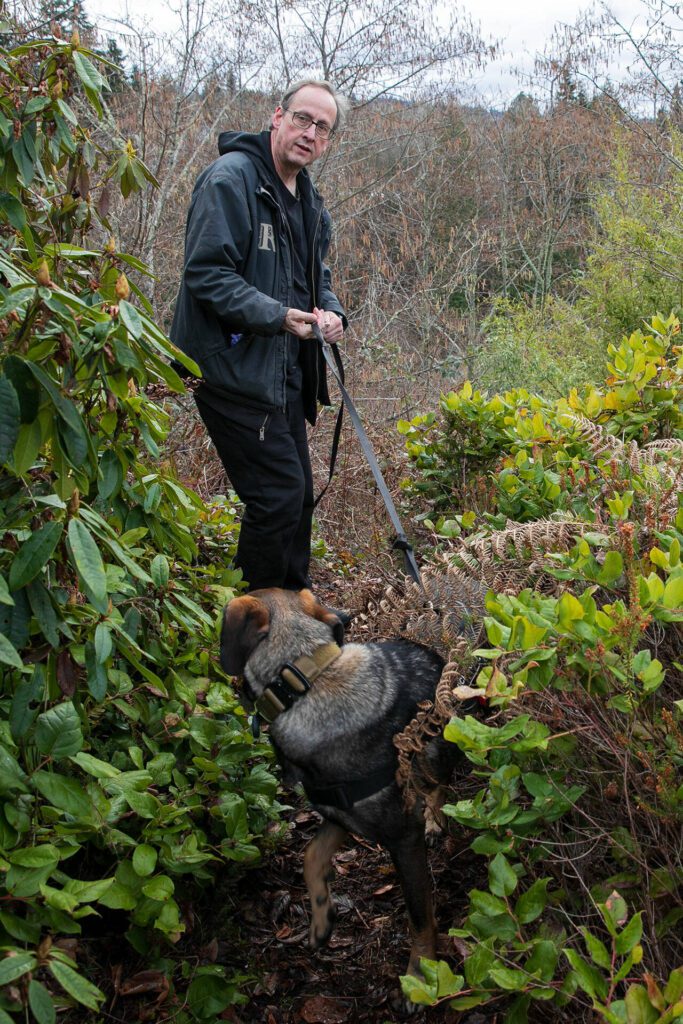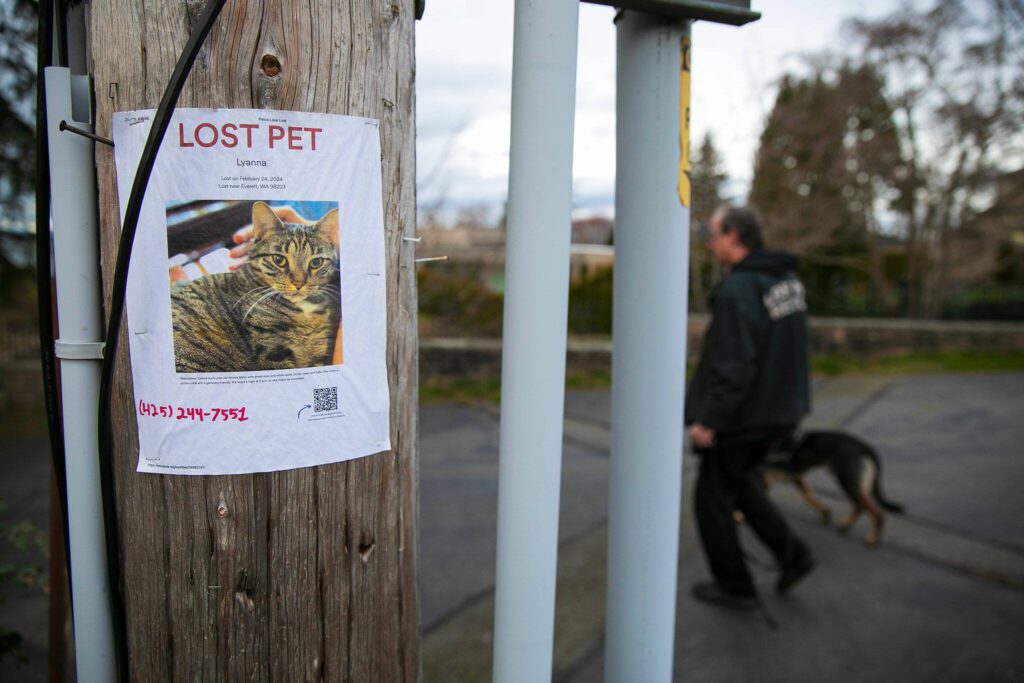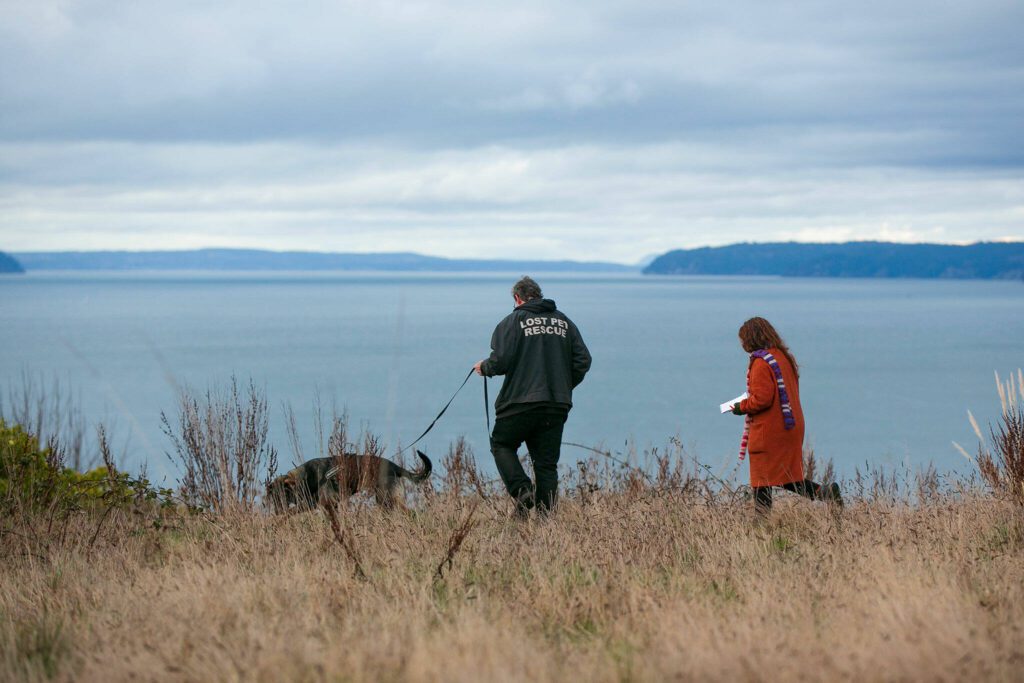Just before 5 a.m. on a February Saturday, my wife woke to what sounded like a cat fight in our back yard.
Unable to sleep, she went to the living room to check on our cat, a 6-year-old gray and black tabby named Lyanna ususally beds down. No Lyanna.
When Lyanna didn’t wake us up in the morning as she usual, panic and sadness took hold.
Losing a pet is a very lonely and confusing experience, as we soon found out.
There’s a long list of things to do. Search in crawl spaces. Scrounge under bushes. Scour the neighborhood. Make posters. Call veterinarians and animals shelters. Most important? Stay persistent.
There’s also plenty of contradictory advice, as we also soon found out. Calling her name might help, or it could make her afraid to leave her hiding place. Putting her litter box outside should help, or it may attract other cats that keep her away. It’s easier to spot a cat during the day, but it’s only late night or very early morning that are good times for a search.
After panic, worry, tears, 4 a.m. searches and feeling like zombies in our everyday lives, a neighbor recommended we hire someone who could help.
James Branson, founder of Three Retrievers Lost Pet Rescue, is a Missing Animal Response Technician or, for short, a pet detective.
He helps people in the Seattle area find their missing pets. His $350 fee includes a phone consultation and the use of a specialized search dog,
At first I was skeptical. How much science could there be to finding a lost pet? I also worried about getting ripped off.
Even Branson acknowledges the business is rife with scammers who prey on owners desperate to reunite with their beloved pet.
But Branson seemed earnest on his social media. He’d even penned extensive guides on how to find lost cats and dogs that he offered for free on his business website 3retrievers.com.
We first talked to him by phone two days after Lyanna went missing. Soft-spoken, he pulled us away from our pervasive feeling of doom. He gave advice, told how much a search would cost and gave us the space to decide what we wanted to do.
After discussing our options for a day, we asked him to look for Lyanna.
For Charlie
In 1997, Branson lost his tuxedo cat Charlie.
“He was very dog-like,” Branson said. “He would run up to greet me when I came home from work, and he would tell me dramatic stories about his day of adventures.”
Over a decade later, while on a walk with his dogs, he saw a flier for training to learn how to find lost pets.
“I do this work because of my cat Charlie,” he wrote in a Substack newsletter he publishes called Three Retrievers Newsletter. “I might have been able to find him if I knew how to look properly back then.”
That class was taught by Kat Albrecht, who now lives in Bellingham.
Albrecht is a former police investigator. One day, she realized that many techniques and skills associated with looking for humans could also be used for pets.
As part of the training, Branson helped find Sophie, a Bernese Mountain Dog who had backed out of her collar on a walk.
For 40 days, Albrach, Branson and a dozen volunteers tried to catch Sophie.
On August 15 2008, Branson did.
To this day, that memory keeps him going through a difficult job that requires him to be there for people in their moment of crisis.
‘They open up the world to me’
Branson, 62, tells us that our suburban neighborhood near Forest Park makes for difficult searching.
According to Branson’s data, 90% of cats are found within 0.2 miles of their home. He gives us a map indicating the yards that need to be searched and tells us we’ll need the owner’s permission.
Out of 64 households we contact, 40 give permission, 15 never respond and nine decline to help.
On searches, Branson wears a custom-made jacket with, “Lost pet rescue” and “The Three Retrievers,” embroidered in the front.
He says that’s in part because he’s 6 foot 4 and, though he has “never heard of someone using a dog in a criminal enterprise before,” he doesn’t want to raise suspicions.
His current line-up of co-workers includes Valentino and Raphael. Mu worked more than 11 years and is now retired. A few more dogs: Bebe, Anna and Ernie are in training.
His favorite part of the job? Getting to work with dogs.
“They open up the world to me,” he said.
He considers them his “superpower.” Together they find things he couldn’t have found on his own.
To keep the dogs fresh, he trains them every week.
Raphael, a 3-year-old rottweiler, is the specialized “cat detection” dog who helps look for Lyanna. Branson also brings Valentino, a scent-tracking dog, but he stays in the car.
Branson gets hundreds of requests for help a year and he turns many down. Sometimes he doesn’t have the time. In other cases, he just knows he won’t be able to help. He admits that his success rate is about 25%.
When looking for cats he searches yards with lots of hiding places. His advice is to look under trees, sheds and other structures. Check for spider webs – undisturbed webs mean that the space likely hasn’t been visited by a 12-pound cat looking for a hiding place, he said.
Sometimes, he lets his dog lead. Other times, he gently directs his dog to “check over here.”
Branson likes to look at gates before going through them, to check for pet ‘traffic.’
He also asks neighbors what time they mowed the lawn, as that can remove evidence.
He never calls pets by their name. According to Branson, rather than drawing them out, the sound of worry in your voice would make the pet hide even more.
‘Your Cat Was Probably a Coyote Snack’
Less than a half hour into our search, we find a pile of coyote scat.
Branson picks it up with a tool.
Sometimes, you can tell what they ate by the fur contained in the scat. Branson reassures us that it’s usually rabbits. With Lyanna and other tabbies, it can be a little tricky. Her coat is kind of “rabbit-like” in Branson’s words, which is why he also looks for claws, teeth and bones.
Still, Branson says not to worry…too much.
“When somebody has been missing a cat, everybody talks about coyotes but it’s statistically unlikely,” he said.
The scat examination in the field is inconclusive, but he takes the sample home in a small bag for later examination.
On one neighbor’s porch, he finds a blanket under a bench where he thinks a cat has been sleeping.
More than once Raphael strains against his leash to go into the few backyards that we don’t have permission to access.
We knock on a neighbor’s door who hasn’t replied to our request, hoping for help.
The neighbor says there’s no way a cat is hiding in his backyard. If so, he’d know and be feeding her because he love cats, he said. He declines our request.
“Your cat was probably a coyote snack,” he says before closing the door.
“Weirdo,” Branson responds as we walk down the driveway, reassuring us again, that cats are rarely eaten by coyotes. “It’s unusual,” he says, commenting on the homeowner’s resistance. “Most people are OK with it.”
After four hours, it’s becoming too dark to search. We’ve found nothing of Lyanna – no fur, no remains, not even her purple collar – to prove she’s alive or dead.
Despite the darkness and the cold, steady drizzle, Branson lingers, talks to us, hears our anguish.
Despite the lack of results, spending so much time with someone who cares about Lyanna as much as we do is its own sort of closure.
Branson says that persistence is key to finding a lost pet. He shares a few theories of what may be keeping Lyanna from coming home. Perhaps it was the barn owl we heard hooting from a large cedar in a neighbor’s yard. Birds like that are unlikely to hurt cats, but may attack them if it feels its territory is being threatened.
Another potential culprit was one of the stray cats that pass through the neighborhood occasionally. There’s a black cat with medium-length hair that’s gone past our window a few times, much to Lyanna’s annoyance. Trapping and removing that cat from her territory might make her feel safe.
The following week, when we text Branson about setting up a humane trap, he drives one to our house. We add fresh bait – a full can of wet cat food with dried bonito flakes sprinkled on top – and move it to a different spot in our yard every few days.
For a few weeks, I procrastinate on writing this essay that I had pitched. My editor said he wanted a happy ending, but it keeps eluding me. Every day for the past five weeks we keep expecting Lyanna to be home, sunning herself by my writing desk or kneading a pile of unfolded laundry. We sit up in the night to the sound of our house settling, wondering if it is maybe her. My wife refreshes her water dish every other day, just in case she is thirsty when she comes home.
37 days later, as I write this, she hasn’t come home.
We still hope for her sense of comedic timing and general contrarian attitude. It may be that only once this article is finalized and off the presses, she shows up, demanding food, water and belly rubs.
I will make sure to submit a correction.
The lucky 25%
I still want to give my editor (and you, the reader) a happy ending and Branson’s newsletter has many stories of pets he did find.
In May 2020, Sharada Mahalingham, a veterinarian from Seattle, was hiking with her lab mix Fia at the Palisades trail in Clearwater near Enumclaw.
Mahalingham was used to hiking with Fia off-leash. Usually, Fia would wander off before returning a while later. One time in Michigan, she was gone for four hours but she always came back.
This time, night was falling and there was still no sight of Fia.
It wasn’t a popular trail. Mahalingham cried and thought of her sister who had first cared for Fia. Mahalingham posted on multiple Facebook groups.
Someone told her to reach out to Branson.
Branson arrived early the next morningwith his dog Valentino.
With a scent article – in this case, a towel with Fia’s scent – Valentino and Branson went looking for Fia.
About a quarter mile downhill from where Fia was last seen, Valentino picked up a scent.
As they came around a corner, they spotted her.
Still, they had to catch her.
And there was a steep 500-foot drop beneath them.
As they came closer, Branson called Mahalingham on the phone and put her on speakerphone.
Fia heard her owner’s voice, relaxed and let Branson and Valentino approach her.
After Branson gave Fia food and water, she was happy to be leashed.
Four years later, Mahalingham and Fia are still happy together. Mahalingham said Branson was key: “I honestly, really don’t think I would have found her if he hadn’t helped.”
Aina de Lapparent Alvarez: 425-339-3449; aina.alvarez@heraldnet.com; Twitter: @Ainadla.
Sound & Summit
This article is featured in the spring issue of Sound & Summit, a supplement of The Daily Herald. Explore Snohomish and Island counties with each quarterly magazine. Each issue is $4.99. Subscribe to receive all four editions for $18 per year. Call 425-339-3200 or go to soundsummitmagazine.com for more information.
Talk to us
> Give us your news tips.
> Send us a letter to the editor.
> More Herald contact information.
